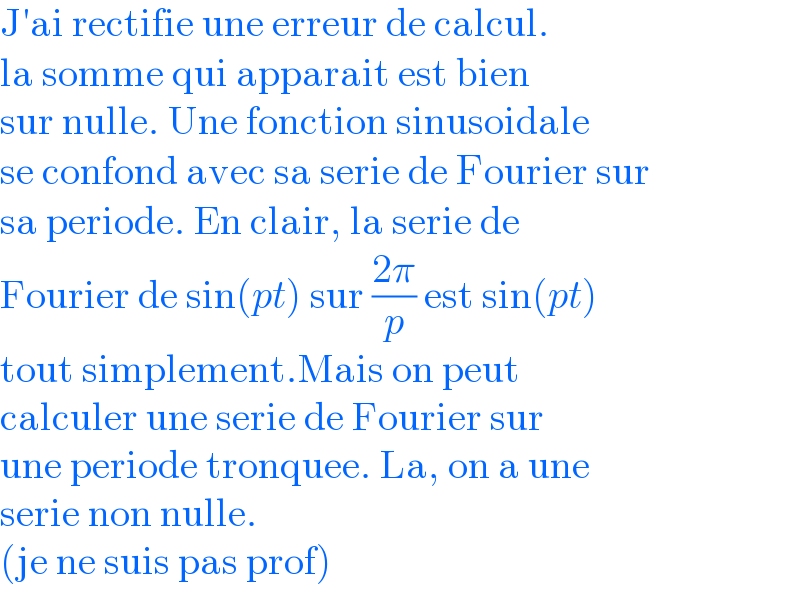
Question and Answers Forum
Previous in Relation and Functions Next in Relation and Functions
Question Number 148237 by puissant last updated on 26/Jul/21

Answered by Olaf_Thorendsen last updated on 26/Jul/21
![f est une fonction impaire et donc a_0 = 0. Les autres a_n sont nuls egalement. La periode T de f est ((2π)/p). • Calculons b_1 a part : b_1 = (2/T)∫_(−(T/2)) ^(+(T/2)) f(t)sin(((2πt)/T)) dt b_1 = (p/π)∫_(−(π/p)) ^(+(π/p)) sin(pt)sin(pt) dt b_1 = (p/π)∫_(−(π/p)) ^(+(π/p)) (1/2)(1−cos(2pt)) dt b_1 = (p/(2π))[t−((sin(2pt))/(2p))]_(−(π/p)) ^(+(π/p)) = 1 • Calculons les autres b_n , n> 1 : b_n = (2/T)∫_(−(T/2)) ^(+(T/2)) f(t)sin(((2πnt)/T)) dt b_n = (p/π)∫_(−(π/p)) ^(+(π/p)) sin(pt)sin(pnt) dt b_n = (p/π)∫_(−(π/p)) ^(+(π/p)) (1/2)[cos(pnt−pt)−cos(pnt+pt)] dt b_n = (p/π)∫_(−(π/p)) ^(+(π/p)) (1/2)[cos((n−1)pt)−cos((n+1)pt)] dt b_n = (p/(2π))[((sin((n−1)pt))/(n−1))−((sin((n+1)pt))/(n+1))]_(−(π/p)) ^(+(π/p)) b_n = (p/π)[((sin((n−1)π))/(n−1))−((sin((n+1)π))/(n+1))]_(−(π/p)) ^(+(π/p)) b_n = (p/π)((((−1)^(n−1) )/(n−1))−(((−1)^(n+1) )/(n+1))) b_n = −((p(−1)^n )/π)((1/(n−1))−(1/(n+1))) b_n = −((p(−1)^n )/(π(n^2 −1))) Remarque : dans l′expression de b_n , le denominateur est nul pour n = 1. C′est pour ca qu′on a pris soin de calculer b_1 a part. Resultat des courses : Sur une periode T = ((2π)/p), on a: f(t) = sin(pt) = sin(pt)−(p/π)Σ_(n=2) ^∞ (((−1)^n )/(n^2 −1))sin(pnt)](Q148243.png)
Commented by Olaf_Thorendsen last updated on 26/Jul/21

